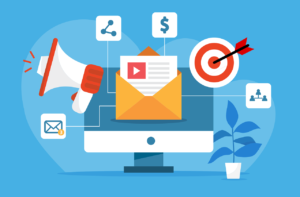Email marketing remains one of the most powerful digital marketing strategies available today. Whether you’re a small business owner, an entrepreneur, or a marketing professional, a strong email marketing strategy can help you generate leads, build customer relationships, and increase conversions. If you’re new to this field, this email marketing guide for beginners will walk you through everything you need to know to create and optimize your campaigns.

What is Email Marketing?
Email marketing is the process of sending targeted messages to an audience via email. Businesses use it for promotional campaigns, customer engagement, and relationship-building. Unlike social media marketing, which relies on algorithms, email marketing allows direct access to a subscriber’s inbox, making it a highly effective and controlled marketing channel.
Why You Need an Email Marketing Strategy
This email marketing guide for beginners emphasizes the importance of having a structured approach. Here’s why email marketing should be a key part of your marketing efforts:
- Direct Communication: Emails land directly in a subscriber’s inbox, offering a personal touch.
- Cost-Effective: Compared to paid advertising, email marketing provides a high return on investment (ROI).
- Audience Targeting: Allows segmentation based on user behavior and demographics.
- Automation: Reduces manual work through autoresponders and drip campaigns.

Part 1: How to Build an Email List Organically
Building an email list organically ensures high engagement rates and better conversion potential. Here are proven strategies to grow your subscriber base:
1. Leverage Social Media Platforms
Social media is a valuable tool for promoting your email list. Here’s how:
- Join industry-relevant groups on Facebook, LinkedIn, and Reddit.
- Engage with your audience by posting valuable content and responding to comments.
- Run giveaways that require users to enter their email addresses to participate.
Example: A fitness trainer can offer a free meal plan to Instagram followers in exchange for their email addresses.
2. Create Problem-Solving Content
People are more likely to share their email addresses when they receive value in return. Provide:
- Free eBooks
- Exclusive newsletters with industry insights
- Video tutorials or webinars
3. Use High-Converting Landing Pages
A dedicated landing page can significantly increase email sign-ups. Optimize it with:
- A compelling headline addressing a pain point.
- A simple opt-in form asking only for necessary details.
- A strong call-to-action (CTA) like “Subscribe Now & Get Your Free Guide!”
4. Offer Lead Magnets
A lead magnet is an incentive that encourages people to sign up. Common lead magnets include:
- Free checklists or templates
- Discount codes for first-time customers
- Access to an exclusive community
Part 2: Buying an Email List – Is It a Good Idea?
While growing an email list organically is the best method, some marketers consider purchasing email lists to speed up the process. This email marketing guide for beginners recommends exercising caution before buying email addresses.
1. Work with Reputable Brokers
If you choose to buy an email list, work with brokers who:
- Offer segmented and verified lists.
- Comply with GDPR and CAN-SPAM regulations.
- Provide transparency on the email sources.
2. Define Your Target Audience
Before purchasing a list, determine the following:
- Demographics: Age, gender, location
- Industry and Interests: What topics they engage with
- Online Behavior: Purchase habits, content preferences
Example: Instead of buying a generic “business owners” list, target “small business owners looking for email marketing solutions.”
3. Test the Email List Before Full Investment
Don’t buy a large list outright. Instead, test a small sample and track:
- Open rates and click-through rates to assess engagement.
- Spam complaints and unsubscribes to gauge list quality.
4. Best Practices for Using Purchased Email Lists
- Never send bulk emails immediately; start with warm-up campaigns.
- Personalize emails to make them feel less like spam.
- Allow recipients to opt out easily.

Part 3: Combining Organic and Paid Strategies for Maximum Impact
A hybrid approach that combines organic growth with paid strategies can be effective. Here’s how:
1. Validate Purchased Lists
Before using a purchased list, run it through email validation tools to remove invalid addresses and reduce bounce rates.
2. Engage New Subscribers Immediately
Send a welcome email introducing yourself and your brand. Include:
- A brief introduction
- What subscribers can expect from your emails
- A strong CTA (e.g., “Download Your Free Resource Now”)
3. Segment Your Email List
Email segmentation improves engagement by targeting specific subscriber groups. Segmentation criteria include:
- New subscribers – Send an onboarding sequence.
- Inactive users – Re-engage with special offers.
- Repeat customers – Provide exclusive deals and updates.
4. Automate Your Email Campaigns
Email automation saves time and ensures consistency. Use autoresponders for:
- Welcome emails
- Abandoned cart reminders
- Personalized product recommendations
Part 4: Optimizing Email Marketing Campaigns for Better Results
Your email marketing guide for beginners wouldn’t be complete without optimization tips. Track and improve performance using these strategies:
1. A/B Testing
Run split tests on:
- Subject lines
- Email content and formatting
- Call-to-action placement
2. Monitor Key Metrics
Analyze your email performance through:
- Open Rate: The percentage of subscribers who open your email.
- Click-Through Rate (CTR): The number of recipients who clicked on a link.
- Conversion Rate: The percentage of users who completed a desired action.
3. Maintain a Healthy Email List
To ensure high engagement, regularly clean your list by:
- Removing inactive subscribers.
- Sending re-engagement campaigns to low-engagement users.
- Ensuring compliance with email marketing laws.

Part 5: Common Mistakes to Avoid in Email Marketing
Many beginners make mistakes that can hurt email campaign performance. Avoid these pitfalls:
1. Sending Emails Without Permission
Never send emails without consent. Always use opt-in forms to build your list legally and ethically.
2. Overloading Subscribers with Emails
Avoid excessive emails that may lead to unsubscribes. Stick to a reasonable frequency (e.g., weekly or bi-weekly).
3. Ignoring Mobile Optimization
Since most emails are opened on mobile devices, always:
- Use a responsive design
- Keep subject lines short
- Use clear, tappable CTA buttons
Mastering Email Marketing as a Beginner
This email marketing guide for beginners has provided a comprehensive roadmap to building, growing, and optimizing your email list. Whether you’re starting from scratch or refining your strategy, following these best practices will help you drive engagement and achieve long-term success.
By focusing on value-driven content, audience segmentation, automation, and ongoing optimization, you can turn your email marketing into a revenue-generating powerhouse. Start building your list today and watch your business grow!
FAQs: Email Marketing Guide for Beginners
1. Is it better to build an email list organically or purchase one?
It depends on your goals. Organic list-building is more time-consuming but ensures high engagement. Purchased lists can provide faster results but require careful targeting.
2. How can I grow my email list without spending money?
Leverage social media, create high-value content, and use lead magnets like free guides or webinars to encourage sign-ups.
3. What are the risks of buying an email list?
Purchased lists can lead to low engagement, spam complaints, or even legal issues if not sourced responsibly.
4. What tools can I use to create landing pages?
Popular tools include Mailchimp, Unbounce, Leadpages, and HubSpot.
5. How often should I email my list?
Start with 1–2 emails per week and adjust based on engagement metrics and feedback.
Conclusion: Email Marketing Guide for Beginners
Email marketing for beginners doesn’t have to be overwhelming. By growing your list organically or purchasing targeted email addresses responsibly, you can build a foundation for successful campaigns. Remember, the key to success is understanding your audience, providing value, and staying consistent in your efforts.

Whether you choose to grow your list over time or take the faster route with a purchased list, always focus on building relationships with your subscribers. An engaged audience is your greatest asset in email marketing.
Let me know if you’d like me to refine or add any specific sections!

